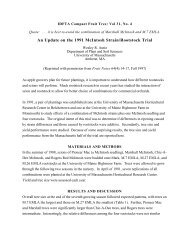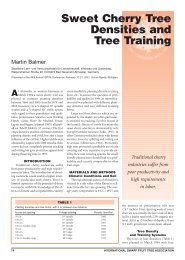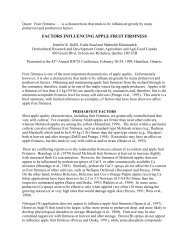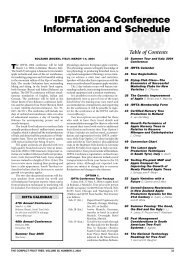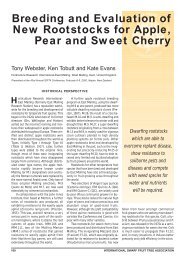Management of High Density Pear Orchards - Virtual Orchard
Management of High Density Pear Orchards - Virtual Orchard
Management of High Density Pear Orchards - Virtual Orchard
- No tags were found...
Create successful ePaper yourself
Turn your PDF publications into a flip-book with our unique Google optimized e-Paper software.
<strong>Management</strong> <strong>of</strong> <strong>High</strong><strong>Density</strong> <strong>Pear</strong> <strong><strong>Orchard</strong>s</strong>T. Deckers and H. Scho<strong>of</strong>sRSF - Royal Research Station <strong>of</strong> Gorsem*, Sint Truiden, BelgiumPresented at the 44th Annual IDFTA Conference, February 17-21, 2001, Grand Rapids, Michigan.The longevity <strong>of</strong> a pear orchard incomparison with an apple orchard ismuch longer. A 10-year-old apple orchardis considered an old orchard with problems<strong>of</strong> insufficient fruit quality (fruit sizeand/or fruit color) and should bereplaced. A high density pear orchard atthe age <strong>of</strong> 10 years is still a young orchardthat comes into optimal productivity for aperiod <strong>of</strong> at least 20 years. The higher theplant density, the more difficult it will beto keep the orchard in the productivephase. In this paper we discuss differentplanting systems for high density pearorchards and the problems <strong>of</strong> excessivevegetative shoot growth that <strong>of</strong>ten occurduring an “<strong>of</strong>f” year after frost damage.Crucial in the management <strong>of</strong> high densitypear plantings is the definition <strong>of</strong> goodflower bud quality with a high potentialfor fruit set.PLANT MATERIALFor pear trees planted in high densityplanting systems the quality <strong>of</strong> the plantingmaterial should be high. It should be a 2-year-old tree with six to eight laterals obtainedby pruning back the 1-year-old treesin the fruit tree nursery. There is an importantdifference in productivity between a 1-year-old feathered tree and a 2-year-oldfeathered tree during the first year afterplanting. When a 1-year-old whip is planted,the productivity will be delayed by a period<strong>of</strong> 2 years during which the frame <strong>of</strong>the tree has to be developed. For intensivehigh density pear plantings only 2-year-oldtrees are recommended. All the lateralsshould not be kept at the start but should bereduced to the final number wanted in theplanting system, e.g., two in the free spindleor four in the V-hedge system. Delayingthis reduction in number <strong>of</strong> laterals to alater date, when the trees are 4 to 5 yearsold, is risky and can cause a problem <strong>of</strong> asilver leaf attack. Many times this silver leafattack is a reaction to a physiological stresssituation (heavy pruning cuts) and cannotbe related to the fungal attack <strong>of</strong> Stereumpurpureum.HIGH DENSITY PLANTINGSYSTEMS FOR PEARThere are tree planting systems that arevery well adapted for high density pear orchards:the V-hedge system, the Tiensehedge system and the free spindle system. Ashort description <strong>of</strong> each <strong>of</strong> these systems isgiven.V-Hedge SystemIn this system we start with 2-year-oldpear trees on Quince C rootstock. Fourequally developed feathers are chosen andkept as fruiting branches. These branchescan be considered as four central leaders onone stem starting at approximately 60 cm(24 inches) above the bud union. The fourfruiting branches are not pruned back atplanting and are bound on a bamboo stick.At the top <strong>of</strong> each fruiting branch, the narrowangled shoots are removed in a veryearly green pinching. In the first year afterplanting these four central axes are coveredwith flower buds. Each flower bud can beconsidered a mixed structure containing theflower bud structure with one or two vegetativebuds at the base <strong>of</strong> the flower budfrom where the shoots will start during thesecond growing season. All the long andstrong 1-year-old shoots should be removedat any time. It is clear that the classical flowerbud formation on the 2-year-old wood isnot important in this pruning system. AfterA high density pearorchard at the age <strong>of</strong>10 years is still ayoung orchard thatcomes into optimalproductivity for a period<strong>of</strong> at least 20 years.4 years the final height <strong>of</strong> the trees <strong>of</strong> about2.2 m (7.2 ft) is reached and then the prolongationshoot is pruned back into the dormantbuds at the base <strong>of</strong> the shoot. Thispruning results in a limited growth reaction<strong>of</strong> two to three shoots starting from the dormantbuds. During the next winter, thispruning can be repeated by pruning back onthe lowest growth reaction and by pruningagain into the dormant buds. The conceptis to keep the vegetative growth on this placeTHE COMPACT FRUIT TREE, VOLUME 34, NUMBER 4, 2001 117
in the tree and that the apical dominancefrom these terminal shoots controls theother growth reactions on the same branch.The productivity in this V-hedge system isbased on flower buds on short spurs and onbourse shoots on the four central leaders.The planting distance in the V-hedgesystem is 3.5 x 1.25 m (11.5 x 4.1 ft) whichmeans 2057 trees/ha (833 trees/acre). Theopening <strong>of</strong> the V is 1.4 m (4.59 ft) at 2 m(6.56 ft) height. There are more intensiveV-planting systems with 3.2 x 0.8 m (10.5 x2.62 ft) planting distance with 3516 trees/ha(1423 trees/acre) and with a more narrowopening <strong>of</strong> 1.2 m (3.94 ft). Under our climatologicalcircumstances it is difficult toallow sufficient light penetration in thesemore intensive V-hedges so flower bud formationis more variable in the intensive V-hedge systems. A disadvantage <strong>of</strong> this V-hedge system is the high amount <strong>of</strong> laborwhich is necessary.Tiense Hedge SystemIn this system we start with 2-year-oldtrees on Quince Adams rootstock also withat least four equally developed feathers onone stem. Two feathers are placed at plantingin the row direction and attached on awire. The two other feathers are placedperpendicular to the row direction andshould help to bring the trees into earlyfertility. The central leader is pruned backto about 70 cm (27 inches) above the lowestscaffold branches and the narrow angledgrowth reactions to that pruning cutare used to form the second level <strong>of</strong> scaffoldbranches. This operation is repeatedfor level three and four <strong>of</strong> the scaffoldbranches. Only two scaffold branches arekept on each level and they are bound ontothe wire structure. The fruit is hangingpredominantly on the short fruiting spurson these limbs and these structures are renewedby pruning them once they getolder. The top <strong>of</strong> the tree is composed <strong>of</strong>the last two scaffold branches. The plantingdistance in this hedge system is 3.5 x 1.75 m(11.5 x 5.7 ft) which means 1632 trees/ha(661 trees/acre).TABLE 1Flower bud quality on young Conference pear trees.Free Spindle SystemIn this system we also start with 2-yearoldtrees on Quince Adams rootstock withmany well-developed feathers. At plantingthe number <strong>of</strong> laterals is limited to tw<strong>of</strong>eathers in the direction <strong>of</strong> the row whichare chosen with a distance <strong>of</strong> about 15 cm(5.91 inches) on the central leader. Thesetwo laterals are tied to an angle <strong>of</strong> about45˚. The central leader as well as the twolaterals is left unpruned. At the end <strong>of</strong> theunpruned central leader, competing lateralswill develop and they have to be removedin a very early stage at a length <strong>of</strong> about10 cm (4 inches).The many flower buds on the centralleader and on the laterals result in earlyproductivity and also in a good start forhorizontal branches starting from thebourse shoot. The first growth reaction onthese flower buds will be a short bourseshoot <strong>of</strong> 10 to 15 cm (4-6 inches) endingon a flower bud. The next year this shortbrindle shoot will develop to a long shoot<strong>of</strong> more than 50 cm (19.7 inches). And inthe third year this long shoot will be coveredagain with short brindle shoots.This sequence <strong>of</strong> short–long–shortshoots on the central leader is very importantfor the free spindle training system.The fruit bearing wood is systematically renewedas much as possible by keepingstrong 1-year-old shoots that are coveredwith flower buds in the second year andwill bear fruit during the third year.When the trees are in a good balancebetween vegetative and generative growththere will be part <strong>of</strong> the flower buds on the2-year-old wood in lateral position. Theseflower buds are later in phenological developmentwhich is an important factorwhen frost damage occurs. The productivity<strong>of</strong> the trees in the free spindle system ismainly on the short brindle shoots on the2-year-old wood and on spurs on thebourse structures. In this training systemthe fertility <strong>of</strong> the flower buds on the 2-year-old wood is important. Conservation<strong>of</strong> some upgrowing new growing shootsleads to differences in branch diameter andindicates the way <strong>of</strong> natural growth <strong>of</strong> the# flower clusters/fruiting branch # flowers/cluster1998 1999 2000 1998 1999 2000on 2-year-old wood 8.10 4.15 9.63 6.29 4.91 6.05on 1-year-old woodin lateral position 7.05 1.85 1.12 7.25 6.68 3.23in terminal position 0.95 0.85 0.19 11.99 9.75 5.13fruit tree. These differences in twig diameterare more accentuated during the seasonby the natural bending tendency <strong>of</strong> thetwigs under the weight <strong>of</strong> the leaves on the1-year-old shoots and under the weight <strong>of</strong>the fruits in terminal position on the fruitbearing twigs.The planting distance in this system is3.75 x 1.5 m (12.3 x 4.9 ft) which means1777 trees/ha (719 trees/acre). An advantage<strong>of</strong> this system is the relatively lowamount <strong>of</strong> labor needed for training andpruning.FLOWER BUD QUALITYThere are important differences inflower bud quality on pear trees. The bestflower bud quality on pear trees can befound on the terminal flower buds on theshort brindle shoots (Table 1).The highest number <strong>of</strong> flowers percluster was found on the flower clusters interminal position on the 1-year-old woodwith more than 10 flowers per cluster. Thenumber <strong>of</strong> flowers per branch can varyconsiderably between years when countedon comparable places in the tree. Sometimesthe crop load can explain these differencesbut sometimes there are other determiningfactors such as climatologicalfactors. For the flower buds on the 1-yearoldwood the growth situation on theshoots has an important influence: late regrowthreactions during season can bevery negative for flower bud formation onthe 1-year-old wood.The number <strong>of</strong> flowers per cluster is animportant parameter <strong>of</strong> flower bud quality.The highest number <strong>of</strong> flowers per clustercan be found on the terminal buds <strong>of</strong>the short brindle shoots. In some years thenumber <strong>of</strong> flowers on this place varies between10 and 15 flowers per cluster whilethe flower buds on the 2-year-old woodhave only 5 to 7 flowers per bud.The number <strong>of</strong> leaves is also an importantflower bud quality criterion. Flowerbuds without leaves have a very low fruitset capacity; they occur on the 1-year-oldshoots with late regrowth reactions; thereis apparently a competition between thisregrowth and the flower bud formation.The presence <strong>of</strong> a bourse shoot at the base<strong>of</strong> a flower cluster significantly increasesthe leaf area <strong>of</strong> a flower cluster. Theseleaves around the flowers increase the fruitset capacity <strong>of</strong> the cluster.The total weight <strong>of</strong> a flower bud alsocan be a good indication for flower budquality and can be determined on differentphenological stages.Internal flower bud quality criteria alsoexist. The number <strong>of</strong> seeds per fruit is118 INTERNATIONAL DWARF FRUIT TREE ASSOCIATION
important for the normal fruit development;this number should be ten undernormal pollination conditions but is <strong>of</strong>tenmuch lower in reality. For pear cultivarssuch as Conference a total parthenocarpicfruit set is possible when the seeds are destroyedin an early stage during night frost.Parthenocarpic fruits <strong>of</strong> Conference are 5to 10 mm (0.2 to 0.4 inches) smaller infruit size than standard fruits with seeds<strong>of</strong> the same pear cultivar. The number andthe dimensions <strong>of</strong> the styles and the anthersare good indications <strong>of</strong> flower budquality on pear trees. The number <strong>of</strong> stylesis normally 5 and the number <strong>of</strong> anthersis normally 20. Flowers with weaker flowerbud quality <strong>of</strong>ten show a reduced shape <strong>of</strong>styles and/or anthers. Also the length <strong>of</strong>the flower stalk is a quality criterion. Flowerswith a short stalk have a very low fruitset capacity. Some flower bud quality parametersare not visible such as thelongevity <strong>of</strong> the nucellus. For the pear cultivarDoyenné du Comice this longevity <strong>of</strong>the nucellus is limited in time and is one <strong>of</strong>the reasons for the difficult fruit setting <strong>of</strong>this cultivar (Demayer and Deckers, 1984).Nitrogen can have a positive influence onthe longevity <strong>of</strong> the ovule and can increasethe effective pollination period (EPP).FLOWER BUD POSITIONNot only the internal structure <strong>of</strong> aflower bud is important but also the position<strong>of</strong> the flower bud on a fruiting branch.In our fruit set trials high fruit set percentagesare <strong>of</strong>ten found for the flower buds interminal position (Table 2). This is knownvery well by the pear growers and thereforeeach fruiting branch is pruned back ontoa flower bud on the 2-year-old wood or ona brindle with a terminal flower bud.There are also important differences infruit set percentages between years on thesame phenological stage. For young peartrees the fruit set percentages <strong>of</strong> the flowerson the 1-year-old wood in lateral positionare also good and the fruit quality <strong>of</strong> thesefruits at harvest is sufficient. For older peartrees there is <strong>of</strong>ten a risk for insufficientfruit quality <strong>of</strong> these fruits with a reducedfruit size. The flower buds on the 1-yearoldwood in lateral position can be considereda reserve <strong>of</strong> flower buds with adelay in phenological evolution <strong>of</strong> about2 weeks that can be very useful in yearswith frost problems during bloom.branch in comparison with the flowerbuds on the underside <strong>of</strong> the same branch.This preferential development <strong>of</strong> structureson the upper side by pear trees is notonly true for flower buds but is also presentfor the development <strong>of</strong> shoots andbourse structures. In this regard it is importantto realize that orientation canchange during the vegetation periodthrough the weight <strong>of</strong> the leaves and/or thefruits. With this process <strong>of</strong> natural bending,there is <strong>of</strong>ten an induction <strong>of</strong> a growthreaction just before the arc on the fruitingbranch. This growth reaction can be consideredthe future fruiting branch but isalso an important factor for vegetativegrowth control on the whole branch. Romand Barritt (1990) found on apple treesthat there was a better fruit quality (fruitweight) for the fruits produced on buds inthe upright position. Volz et al. (1992) confirmedthat for Granny Smith there is alsoa difference in fruit quality between fruitsin different positions: the fruits on the 2-year-old wood and on the 1-year-old woodin terminal position are comparable inTABLE 2fruit weight while the fruits on the 1-yearoldwood in lateral position were significantlylower. They found also differencesin mineral composition <strong>of</strong> the fruits withthe best Ca content for the fruits on the 1-year-old wood in terminal position. Thiscould be linked with a significantly higherleaf area per bloom cluster.For Conference pear trees, the situationis similar with very good fruit size for thefruits on the short brindle shoots in terminalposition and for the fruits producedon well-developed 2-year-old branchespruned back into the flower buds.The differences in development for differentorientations are not only present forthe flower clusters but also for the shootdevelopment on a fruiting branch. Brunnerand Kecskes (1990) described thebranching pattern <strong>of</strong> apple and pear cultivarsas epitonic, while the development <strong>of</strong>the branches above the horizontal isstronger than under the horizontal. Thesedifferences in development <strong>of</strong> the branchesare also reflected in differences inbranch diameter and indicate the naturalFruit set % on young Conference pear trees for flower buds in different positions.% fruit set in 1998 after % fruit set in 1999 afterflower drop June drop flower drop June dropon 2-year-old wood 3.34 0.13 21.51 9.00on 1-year-old woodin lateral position 8.95 2.16 39.70 13.47in terminal position 11.94 2.24 34.23 11.91FIGURE 1Dominant (Twig A) and dominated (Twig B) branches on a fruiting scaffold limb <strong>of</strong> pear. Twigs Aand B are both 2-year-old twigs on an older fruiting limb. On the places (1) and (2) we can see areduction in branch diameter caused by the presence <strong>of</strong> Twigs A and B. This reduction in diameterindicates the natural tendency <strong>of</strong> the branch to grow to Twig A. We consider Twig A the dominanttwig. Twig B and all structures farther away from the central leader can be considered dominatedstructures. Pruning back into the flower buds <strong>of</strong> the 2-year-old wood during wintertime on Twig Aand Twig B will give a totally different growth reaction; the growth reaction will be strongest onTwig A.Central leader2 y1 yTwig A2 y1 yTwig BFLOWER BUD ORIENTATIONThe placement <strong>of</strong> a flower bud on afruiting branch determines the development.There is a clear superiority <strong>of</strong> flowerbuds on the upper side <strong>of</strong> the fruiting(1)(2)THE COMPACT FRUIT TREE, VOLUME 34, NUMBER 4, 2001 119
growth habits <strong>of</strong> the tree. These differencesin branch diameter should be taken intoaccount during the winter pruning. Thesebranches can be classified as dominant oras dominated structures and the response<strong>of</strong> the same pruning cut will be totally differentwhen it is made in dominant twig orin dominated branch, even when thebranches have the same age (Fig. 1).EARLY PRODUCTIVITYFor intensive pear orchards early productivityis a must for economical reasonsas well as for natural growth control. Thefirst pears should be harvested in the secondyear after planting with productivityestimated at 3 to 5 kg/tree (6.6 to 11 lb/tree). Gibberellin treatments can help toimprove this early productivity on youngConference trees. In Table 3 some resultsare summarized with different gibberellintreatments applied during full bloom ontrees in their second season after planting.This trial was made on young Conferencetrees on Quince Adams in the secondyear after planting. The GA 3 treatment inthis trial was made as tablets <strong>of</strong> 10 g(0.022 lb) each containing 1 g active ingredientper tablet (0.0033 lb). The GA 4/7 was appliedas Regulex, containing 9 g/l GA 4/7(0.02 lb). For fruit set improvement, the GA 3treatment is clearly stronger than the GA 4/7 .The different forms <strong>of</strong> GA 4/7 have a comparablepositive effect on fruit set. For a fertilepear cultivar like Conference, it is not alwaysnecessary to take the strongest fruit set effect.Splitting up the total dose <strong>of</strong> GA 4/7 in twotreatments, one during full bloom on the 2-year-old wood and one during full bloomTABLE 3on the 1-year-old wood some days later, canbe interesting during variable climatologicalconditions. Also the combination <strong>of</strong> alow dose <strong>of</strong> GA 3 and half dose <strong>of</strong> GA 4/7looks promising. On young trees the risk fornegative effects on fruit size or on return tobloom is very limited but on adult trees riskshould be taken into account.The global result <strong>of</strong> these gibberellinapplications is different from year to yearwith sometimes substantial differences butin other years with no differences. The fruitset improvement is only one factor in thewhole series <strong>of</strong> phytotechnical measuresthat determines the final result.NUTRITIONMost <strong>of</strong> the Belgian pear orchards haveno possibilities for irrigation or fertigation.Nitrogen and potassium are two importantnutritional elements for pear growingin Belgium, nitrogen for an optimal fruitset and potassium for an optimal fruitquality. After the loss <strong>of</strong> chloormequat(CCC) as growth regulator there is a tendencyto reduce nitrogen partially or evencompletely in Belgian pear growing. Thiscould be negative for the normal fruit setcapacity <strong>of</strong> the flowers which need nitrogenavailable in the NO 3 form duringbloom and immediately afterwards duringthe process <strong>of</strong> flower drop and fruitletdrop. Postharvest applications <strong>of</strong> nitrogenare <strong>of</strong>ten used to improve the nitrogen reservelevel in the tree and to avoid vegetativegrowth reactions on the trees. Postharvestnitrogen can be applied by the roots oras a leaf nitrogen application with urea.Part <strong>of</strong> the nitrogen should always be givenFruit set improvement on young Conference pear trees with different gibberellin treatments (ns=nosignificance; *=significance <strong>of</strong> 95%; **=significance <strong>of</strong> 99%).% fruit set 2 yr wood after % fruit set 1 yr wood afterflower drop June drop flower drop June drop # pears/tree1. Untreated 18.4 8.7 25.2 11.5 33.62. GA 3 (10 tablets/ha) 35.3 ** 25.5 ** 32.8 ** 19.6 ** 44.0 ns3. GA 4/7 (1.2 l/ha) 23.7 ns 15.1 ns 23.4 ns 14.7 * 36.4 ns4. Promalin (0.6 l/ha) 22.2 ns 15.1 * 25.9 ns 14.6 ns 37.1 ns5. GA 3 (10 tabl.) + 27.1 * 18.1 ** 27.8 ns 20.5 ** 34.6 nsGA 4/7 (0.6 l/ha)6. GA 4/7 (2 x 0.6 l/ha) 24.9 ns 16.7 * 32.5 ** 20.1 ** 39.9 nssome weeks before bloom (20 to 30 kgN/ha; 17.8 to 26.7 lb/acre). This ensuresthat nitrogen will be available duringbloom for optimal fruit set. Early leafanalysis can give useful information on thenitrogen content during the floral andpostfloral period.CONCLUSION<strong>Pear</strong> growing in high density plantingsis possible with different training systemsbut there are important differences inlabor needed for each system. Planting materialfor intensive growing should be wellfeathered2-year-old trees with at least 6feathers. Information on flower bud qualityon different structures in the pear treecan help improve the regularity <strong>of</strong> theyield. The best flower bud quality on pearis found on the terminal flower buds onshort brindle shoots. Flower buds in terminalposition give higher fruit set percentagesthan in other positions. <strong>Pear</strong> treeshave an epitonic behavior, which meansthat the development <strong>of</strong> flower buds andshoots is better on the upper side <strong>of</strong> thebranches. The use <strong>of</strong> gibberellins is necessaryto guarantee the early productivity <strong>of</strong>young pear trees. Nitrogen is important fora regular fruit set on young pear trees andshould be available during bloom and justafter bloom.REFERENCESBrunner, T. and I.K. Kecskes. 1990. Physiological fruittree training for intensive growing. Budapest:Akademiai Kiado.Demayer, L. and J.C. Deckers. 1984. Flower bud qualityin the pear cultivar Doyenné du Comice:1982–1983 trials. Acta Hort. 149:153–160.Rom, C.R. and B.H. Barritt. 1990. Spur development<strong>of</strong> Delicious apple as influenced by position,wood age, strain and pruning. HortScience25(12):1578–1581.Volz, R.K., E.W. Hewett and D.J. Wooley. 1992. Applefruit quality variation within the tree canopyat harvest. Postharvest Physiology Conference,California.*Research subsidized by the Ministry <strong>of</strong>Small Enterprises, Traders and Agriculture,Administration for Researchand Development120 INTERNATIONAL DWARF FRUIT TREE ASSOCIATION



